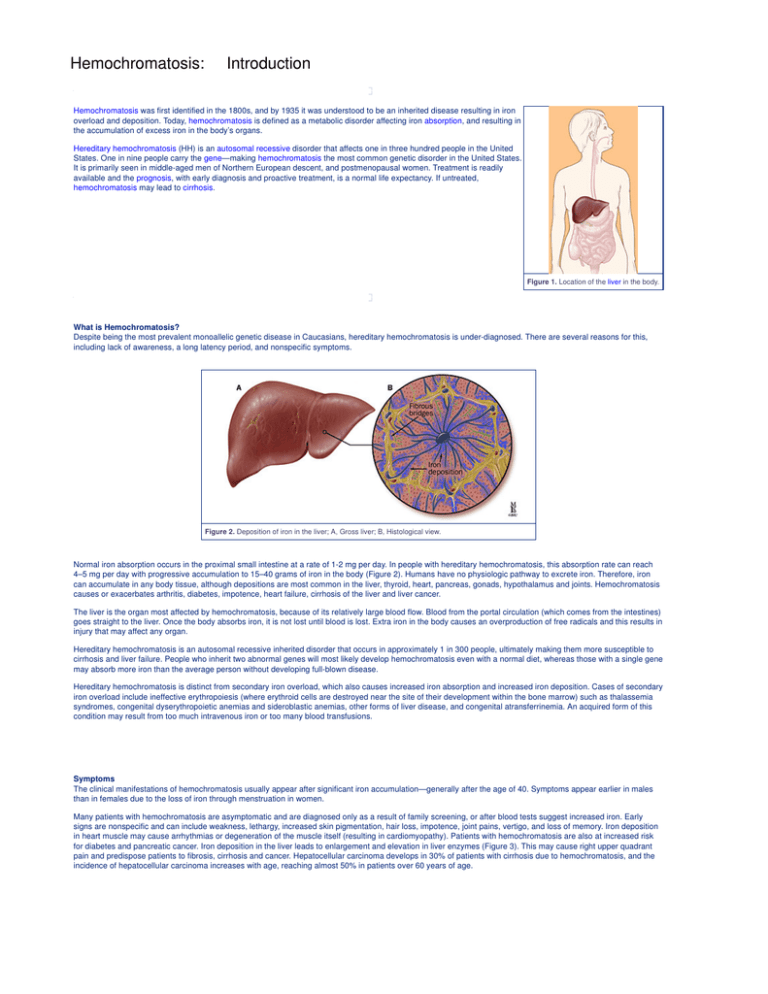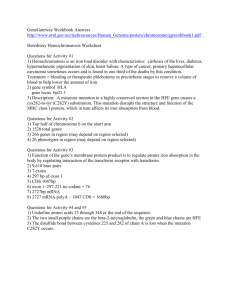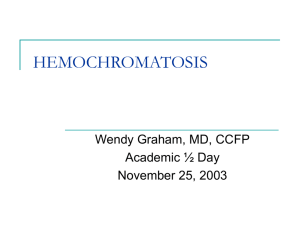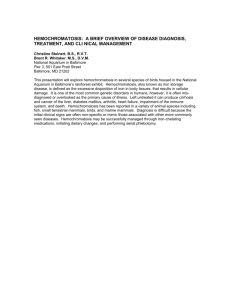
Hemochromatosis:
Introduction
Hemochromatosis was first identified in the 1800s, and by 1935 it was understood to be an inherited disease resulting in iron
overload and deposition. Today, hemochromatosis is defined as a metabolic disorder affecting iron absorption, and resulting in
the accumulation of excess iron in the body’s organs.
Hereditary hemochromatosis (HH) is an autosomal recessive disorder that affects one in three hundred people in the United
States. One in nine people carry the gene—making hemochromatosis the most common genetic disorder in the United States.
It is primarily seen in middle-aged men of Northern European descent, and postmenopausal women. Treatment is readily
available and the prognosis, with early diagnosis and proactive treatment, is a normal life expectancy. If untreated,
hemochromatosis may lead to cirrhosis.
Figure 1. Location of the liver in the body.
What is Hemochromatosis?
Despite being the most prevalent monoallelic genetic disease in Caucasians, hereditary hemochromatosis is under-diagnosed. There are several reasons for this,
including lack of awareness, a long latency period, and nonspecific symptoms.
Figure 2. Deposition of iron in the liver; A, Gross liver; B, Histological view.
Normal iron absorption occurs in the proximal small intestine at a rate of 1-2 mg per day. In people with hereditary hemochromatosis, this absorption rate can reach
4–5 mg per day with progressive accumulation to 15–40 grams of iron in the body (Figure 2). Humans have no physiologic pathway to excrete iron. Therefore, iron
can accumulate in any body tissue, although depositions are most common in the liver, thyroid, heart, pancreas, gonads, hypothalamus and joints. Hemochromatosis
causes or exacerbates arthritis, diabetes, impotence, heart failure, cirrhosis of the liver and liver cancer.
The liver is the organ most affected by hemochromatosis, because of its relatively large blood flow. Blood from the portal circulation (which comes from the intestines)
goes straight to the liver. Once the body absorbs iron, it is not lost until blood is lost. Extra iron in the body causes an overproduction of free radicals and this results in
injury that may affect any organ.
Hereditary hemochromatosis is an autosomal recessive inherited disorder that occurs in approximately 1 in 300 people, ultimately making them more susceptible to
cirrhosis and liver failure. People who inherit two abnormal genes will most likely develop hemochromatosis even with a normal diet, whereas those with a single gene
may absorb more iron than the average person without developing full-blown disease.
Hereditary hemochromatosis is distinct from secondary iron overload, which also causes increased iron absorption and increased iron deposition. Cases of secondary
iron overload include ineffective erythropoiesis (where erythroid cells are destroyed near the site of their development within the bone marrow) such as thalassemia
syndromes, congenital dyserythropoietic anemias and sideroblastic anemias, other forms of liver disease, and congenital atransferrinemia. An acquired form of this
condition may result from too much intravenous iron or too many blood transfusions.
Symptoms
The clinical manifestations of hemochromatosis usually appear after significant iron accumulation—generally after the age of 40. Symptoms appear earlier in males
than in females due to the loss of iron through menstruation in women.
Many patients with hemochromatosis are asymptomatic and are diagnosed only as a result of family screening, or after blood tests suggest increased iron. Early
signs are nonspecific and can include weakness, lethargy, increased skin pigmentation, hair loss, impotence, joint pains, vertigo, and loss of memory. Iron deposition
in heart muscle may cause arrhythmias or degeneration of the muscle itself (resulting in cardiomyopathy). Patients with hemochromatosis are also at increased risk
for diabetes and pancreatic cancer. Iron deposition in the liver leads to enlargement and elevation in liver enzymes (Figure 3). This may cause right upper quadrant
pain and predispose patients to fibrosis, cirrhosis and cancer. Hepatocellular carcinoma develops in 30% of patients with cirrhosis due to hemochromatosis, and the
incidence of hepatocellular carcinoma increases with age, reaching almost 50% in patients over 60 years of age.
Figure 3. Symptoms and signs of hemochromatosis.
Most of the outward manifestations of hemochromatosis are the result of iron deposition in the organs. Exceptions include the bronze color of a patient’s skin—which
is due to increased melanin deposition—and arthritis, which is due to calcium pyrophosphate crystal accumulation (pseudogout). Arthritis develops in 25–30% of
patients and initially involves the second and third metacarpophalangeal joints (Figure 4). Thereafter, a progressive polyarthritis involving the wrists, hips, knees, and
spine may ensue. Hypogonadism is the result of decreases in follicle stimulating hormone and luteinizing hormone secretion (from iron deposition in the anterior
pituitary gland) and is manifested through impotence in males and amenorrhea in females. Primary testicular failure and atrophy may also occur from iron deposition
in the testes.
Figure 4. Arthritis of the hand.
© Copyright 2001-2013 | All Rights Reserved.
600 North Wolfe Street, Baltimore, Maryland 21287
Hemochromatosis:
Anatomy
The liver is located in the right upper quadrant, between the fifth intercostal space in the midclavicular line and the right costal margin. It weighs approximately 1800
grams in men and 1400 grams in women. The surfaces of the liver are smooth and convex in the superior, anterior and right lateral regions. Indentations from the
colon, right kidney, duodenum and stomach are apparent on the posterior surface (Figure 5).
Figure 5. Anatomy of the liver; A, gross view; B. histological view.
The line between the vena cava and gallbladder divides the liver into right and left lobes. Each lobe has an independent vascular and duct supply. The lobes are
further divided into eight segments, each containing a pedicle of portal vessels, ducts, and hepatic veins.
The portal venous system extends from the intestinal capillaries to the hepatic sinusoids. This system carries blood from the abdominal gastrointestinal tract, the
pancreas, the gallbladder and the spleen back to the heart (coursing through the liver) (Figure 6). The largest vessel in this system is the portal vein, which is formed
by the union of the splenic vein and superior mesenteric veins. The left gastric and right gastric veins and the posterior superior pancreaticoduodenal vein drain
directly into the portal vein. The portal vein runs posterior to the pancreas and its extrahepatic length is anywhere from 5 to 9 centimeters. At the porta hepatis, it
divides into the right and left portal veins within the liver, and the cystic vein typically drains into the right hepatic branch.
Figure 6. Veins of the portal circulation.
The portal vein supplies 70% of the blood flow to the liver, but only 40% of the liver oxygen supply. The remainder of the blood comes from the hepatic artery. Blood
from both vessels mixes in the sinusoids (Figure 7).
The liver receives a tremendous volume of blood, on the order of 1.5 liters per minute—and the dual blood supply from the portal vein and the hepatic artery allows it
to be relatively resistant to hypoxemia. Unlike the systemic vasculature, the hepatic vascular system is less influenced by vasodilation and vasoconstriction. This is
due to the fact that sinusoidal pressures remain relatively constant in spite of changes in blood flow. A classic example is hepatic vein occlusion resulting in high
sinusoidal pressure and extracellular extravasation of fluid. To maintain a constant inflow of blood into the liver, hepatic artery blood flow is inversely related to portal
vein flow. This appears to be hormonally mediated rather than neurally mediated, since it persists even in the transplanted liver.
Figure 7. A, Histological anatomy of the liver lobule; B, and portal triad.
© Copyright 2001-2013 | All Rights Reserved.
600 North Wolfe Street, Baltimore, Maryland 21287
Hemochromatosis:
Causes
Genetics
Iron overload is the result of increased absorption of dietary iron. The regulatory defect appears to be in the membrane iron transport system in duodenal mucosal
cells. The inheritance of the hemochromatosis trait is autosomally recessive. It has been estimated that hereditary hemochromatosis affects 1 in 300 individuals, while
1 in 9 Americans carry the gene. The gene defect has been associated with HLA-A on the short arm of chromosome 6. Recently the hemochromatosis gene was
identified and located 3,000 kb distal to HLA-A (Figure 8). It codes for a protein called HFE. Most affected individuals carry a missense mutation (C282Y) that alters
the protein product through substitution of cystine for tyrosine. Clinical hereditary hemochromatosis (HH) generally develops in people with two copies of this
mutation, but subgroups of heterozygous individuals have also been identified.
Figure 8. Chromosome 6, the HLA-A gene and the locus of the C282Y mutation.
Another associated mutation, H63D (substitution of histidine by aspartate), has been found and is harmful if present in a person heterozygous for C282Y (Figure 9). In
a recent study of 178 patients with hemochromatosis, 147 (83%) were homozygous for C282Y, 9 (5%) were heterozygous and16 (12%) non-carriers. In addition, 8 of
the 9 subjects found to be heterozygous for C282Y were also heterozygous for H63D (compound heterozygous, C282Y/H631). Subsequently it was shown that the
homozygous C282Y/C282Y mutation is responsible for 61-92% of the cases of hemochromatosis in different populations around the world. Compound heterozygous
(C282Y/H631) individuals may develop increased iron overload and are at increased risk of developing hemochromatosis.
Figure 9. Chromosome 6, the H63D gene and the locus of the H63D mutation.
A subgroup of patients with clinical HH does not have mutations in the HFE gene. Although their disease to be hereditary, the genetic cause has not been found.
Mechanism
The HFE protein, a product of the HFE gene, is associated with the transferrin receptor/transferrin complex in the duodenal epithelia. The role of the HFE protein in
this complex is to modulate the uptake of transferrin-bound iron into intestinal epithelial cells, allowing the complex to act as sensors of body iron stores. Mutation of
HFE protein leads to up-regulated, increased iron absorption. Increased intracellular iron causes peroxidative injury to phospholipids of organelle membranes such as
lysosomes, mitochondria and microsomes. Free iron is an important component in the formation of highly reactive hydroxy radicals, which initiate lipid peroxidation.
Lipid peroxidation induces cell degeneration, cell death, and collagen biosynthesis leading to fibrosis and cirrhosis (Figure 10).
Figure 10. The mechanism of iron-induced cellular toxicity and liver fibrosis. (Click on the blue letters to
view the consecutive images)
© Copyright 2001-2013 | All Rights Reserved.
600 North Wolfe Street, Baltimore, Maryland 21287
Hemochromatosis:
Diagnosis
Overview
The diagnosis of hemochromatosis is made by patient history, physical examination, blood tests and liver biopsy. Patients who present with symptoms suggestive of
hereditary hemochromatosis, such as hepatomegaly, arrhythmias, cardiac insufficiency, diabetes mellitus, abnormal liver function tests (LFTs), hyperpigmentation or
hypergonadism should be evaluated for hemochromatosis.
The demonstration of a high serum iron, transferrin-saturation (serum iron/total iron binding capacity) greater than 60% in men and post-menopausal women or 50%
in premenopausal women, and an elevated serum ferritin value suggests hereditary hemochromatosis. The combination of elevated transferrin saturation and an
elevated serum ferritin is associated with a sensitivity of 0.94 and a specificity of 0.86 in the detection of early hemochromatosis.
Figure 11. Technique of liver biopsy.
A liver biopsy is recommended in patients with elevations of both serum transferrin saturation and serum ferritin to evaluate the extent of iron overload and hepatic
damage. Biopsy remains the gold standard for quantifying iron and estimating prognosis (Figure 11). The liver biopsy specimen is stained with Prussian blue for iron.
The pattern and amount of iron deposition are then evaluated. Iron deposits in the liver consist of ferritin and hemosiderin. In the early stages, iron is found in
periportal hepatocytes, especially in lysosomes. In more advanced disease, there is perilobular fibrosis and deposition of iron in the bile duct epithelium, Kupffer cells,
and fibrous septa and eventually the development of cirrhosis (Figure 12). Measurement of hepatic iron concentration with determination of the hepatic iron index
(hepatic iron concentration in pmoles/gm dry weight/age in years) is useful in diagnosis. Patients with genetic hemochromatosis have an index greater than 2.0.
Computed tomography (CT) or magnetic resonance imaging (MRI) can also detect hepatic iron overload, but their sensitivity is low and they do not provide
information on the degree of associated liver damage.
Figure 12. Natural history of iron overload in liver disease. Gross liver and histological section. (Click
on the blue letters to view the consecutive images)
Finding a homozygous genotype C282Y/C282Y in a patient with iron overload confirms the diagnosis of hemochromatosis, but does not diagnose cirrhosis or suggest
prognosis. A small group of homozygotes have no clinical or biochemical evidence of iron overload, so the test is not predictive of disease state. Compound
heterozygous C282Y/H63D have a four-fold increased risk of hemochromatosis as compared with the general population. Homozygous genotype H63D/H63D is not
associated with increased iron deposition.
Screening
First-degree relatives of patients with HH should be screened for the disease. However, a definitive screening strategy has not been established. Screening should
start between the ages of 18-30 (when iron studies are abnormal but serious organ damage has not occurred). Initial testing should include a fasting transferrin
saturation and ferritin concentration. Incorporation of genetic testing has been controversial. Cost analysis suggests that screening for homozygosity for the C282Y
mutation in first-degree relatives is cost-effective. The patient should be gene tested and if positive the spouse should be tested. If the spouse is heterozygous the
children should be tested. Siblings of a homozygous patient should also be tested. Individuals identified as C282Y/C282Y or C282Y/H63D should undergo
biochemical screening (iron studies) (Figure 13).
Figure 13. Family tree.
Population screening is more controversial. Cost-effectiveness studies suggest that screening asymptomatic white men with iron studies is comparable to other
common medical interventions. Arguments against genetic screening, however, suggest that homozygous individuals could face discrimination from health and life
insurers if identified, and point out that the test is not always predictive.
© Copyright 2001-2013 | All Rights Reserved.
600 North Wolfe Street, Baltimore, Maryland 21287
Hemochromatosis:
Therapy
Overview
Treatment of patients with hemochromatosis is initiated whenever an elevated transferrin saturation and serum ferritin (>200 mcg/l) has been demonstrated. The
treatment consists of removal of iron by phlebotomy (Figure 14). One unit of blood (500 ML) typically contains 200-250 mg of iron. At phlebotomy, 500 mL of blood is
removed weekly until serum iron and serum ferritin fall into the deficient range, and percent saturation of transferrin falls below 15%. It may take years to deplete the
iron stores of individuals with symptoms, but with early diagnosis 30 or fewer phlebotomies are likely sufficient. Patients with cardiac disease may only tolerate
removal of 0.5 units of blood weekly. Thereafter, the frequency of phlebotomy is reduced to maintain a serum ferritin of 50 mcg/l. Typically for maintenance, men will
require phlebotomy 3-4 times a year and women 1-2 times per year. In all cases, hemoglobin needs to be monitored so that marked anemia is avoided. Phlebotomy
should be continued for the life of the individual.
In rare cases, patients are unable to tolerate phlebotomy. In these instances chelation therapy with deferoxamine should be considered.
Figure 14. Phlebotomy technique.
Patients should avoid iron supplementation and restrict their vitamin C and ethanol intake as these both facilitate iron absorption. In addition they should avoid raw
shellfish, as they are more susceptible to Vibrio vulnificus infection.
Therapy has many benefits. If initiated early, it will prevent cirrhosis and other complications of iron overload, as well as decreasing the risk of hepatocellular
carcinoma . In addition to increasing life span, therapy should improve or alleviate almost all symptoms (except for hypogonadism and arthropathy).
Overview
Phlebotomy has been found to markedly improve symptoms of weakness, lethargy, and abdominal pain and to decrease hepatomegaly and serum
aminotransferases. However, endocrine and arthropathic changes only improve in approximately 25% of patients. Glucose intolerance and insulin requirements
decrease in some patients. No reversal of cirrhosis has been documented. There is no evidence that iron depletion by phlebotomy decreases the high incidence of
hepatocellular carcinoma. Phlebotomy, however, increases survival in patients with pre-cirrhosis hemochromatosis who can be depleted of iron within 18 months of
phlebotomy. Pre-cirrhotic patients depleted of iron with venesection have a normal life expectancy. Cancer surveillance should include yearly physical examination
and biannual imaging with serum alpha-fetoprotein (Figure 15).
Figure 15. A, Hepatocellular carcinoma located in a cirrhotic liver; B, corresponding histological
section.
Liver transplantation is an appropriate therapy in patients with advanced cirrhosis due to hemochromatosis (Figure 16). However, survival is decreased when
compared with patients transplanted for cirrhosis of other etiologies. One study, examining 22 patients with hemochromatosis, showed a median survival of 2.8 years
after liver transplantation with the longest survival being 5.5 years. Percent transferrin saturation and serum ferritin fell within 6 months in all patients, and liver iron
remained normal in the transplanted livers. However, the time period of follow-up was too short to determine the extent of iron re-accumulation.
Figure 16. Liver transplantation.
© Copyright 2001-2013 | All Rights Reserved.
600 North Wolfe Street, Baltimore, Maryland 21287







